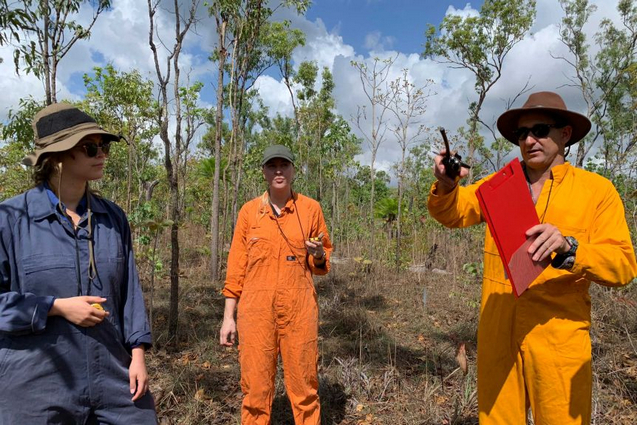Modelling shows moving towards a net zero emissions economy would unlock financial prospects in sectors including renewables and manufacturing
 |
| Analysis finds if Australia keeps to its current climate policies, investment worth $43bn would be lost over the next five years, growing to $250bn by 2050. Photograph: Carly Earl/The Guardian |
The analysis, by the Investor Group on Climate Change (IGCC), finds the investment opportunity created by an orderly transition to a net zero emissions economy would reach hundreds of billions of dollars by 2050 across sectors including renewable energy, manufacturing, carbon sequestration and transport.
However, if the country keeps to its current targets and climate policies, investment worth $43bn would be lost over the next five years, growing to $250bn by 2050.
The Investor Group on Climate Change represents investors in Australia and New Zealand who are focused on the effect of the climate crisis on the financial value of investments.
Among its membership are institutional investors with funds under management worth more than $2 trillion.
The organisation commissioned the consultancy Energetics to examine the domestic investment opportunities that would arise from an orderly transition to net zero emissions by 2050.
The report finds a net zero scenario would unlock $63bn in investment over the next five years, including $15bn in manufacturing, $6bn in transport infrastructure such as charging stations, and $3bn in domestic green hydrogen production, as companies and governments moved towards the stronger emissions goal.
Carbon sequestration – or carbon farming – would emerge as a major investment asset class, with estimated investment worth $33bn in nature-based solutions such as tree planting and assisted regeneration of deforested land.
The investment potential would reach hundreds of billions of dollars over the longer term to 2050, including $385bn in clean electricity, $350bn in domestic green hydrogen, $104bn in transport infrastructure and $102bn in carbon sequestration.
“What it shows is that the investment opportunities extend well beyond just the renewables industry,” said Erwin Jackson, the IGCC’s director of policy.
“Renewables are the backbone of the transition but there are massive opportunities in other sectors such as manufacturing, restoring the land, and electrification of transport.”
The report, which targets governments, companies, investors and financial regulators, says its estimates are conservative because they do not factor in the export potential of industries such as clean hydrogen.
It argues that if governments set stable policy, and companies and investors collaborate to align their decisions with the goals of the Paris agreement, then billions of dollars over the short and long term could support the jobs and wealth of millions of Australians, particularly in regional areas.
The Morrison government has refused to commit Australia to a net zero emissions target and has focused its climate policy on a new technology roadmap covering hydrogen, energy storage, “low carbon” steel and aluminium, carbon capture and storage, and soil carbon.
Under the roadmap, the government claims it will invest $18bn in technologies over 10 years.
The IGCC report notes that more than half of Australia’s two-way trading partners have set targets to reach net zero emissions by mid-century.
It warns that a business as usual “hothouse” scenario in Australia – with no net zero emissions target – would produce $43bn less in investment over five years and $250bn less by 2050 than what would be possible with a net zero target.
“Put bluntly, capital is global and it wants to invest in climate change solutions because they see it as delivering more on their long term investments,” Jackson said. “They’re going to invest more in countries that have durable, credible policies to achieve net zero emissions by 2050.”
John Connor, the chief executive of the Carbon Market Institute, said the reality Australia faced was its economy was running “below capacity and it needs a new direction”.
He said clean technologies like renewable energy and transport represented significant opportunities for Australia in a post-carbon world and the country’s vast land mass, with landscapes in need of regeneration, gave it a competitive advantage in carbon sequestration.
“We can either coast off the cliff into the hothouse of economic and climate disaster, or we can turn a corner towards an orderly transition and the opportunities that are there,” Connor said.
Links
- Net zero emissions by 2050: is it a controversial ambition and will the Coalition adopt it?
- Morrison's rejection of 2050 net zero emissions target is at odds with Paris agreement, experts say
- Scott Morrison refuses to commit to net zero emissions target by 2050
- Australia's carbon emissions fall just 0.3% as industrial pollution surges
- Australia isn't on track to meet its 2030 emissions target, UN report says
- PM claims Australia will meet Paris target 'in a canter' despite emissions climbing
- Coalition balks on Finkel target but will unveil energy and emissions policy
- BlueScope Steel backs low emissions target as way to achieve energy balance
- Renewable energy spike led to sharp drop in emissions in Australia, study shows
- Government 'clean coal' push would be likely to make Australia's emissions worse
- ‘Green hydrogen’ from renewables could become cheapest ‘transformative fuel’ within a decade
- Narrabri gas project: former judge questions independence of NSW planning commission
- Narrabri gas project: do we need it and what's at stake for Australia's environment?
- Australia joins US, China and Russia in refusing to sign leaders' pledge on biodiversity
- No penalty for Victoria despite 'wanton destruction' of trees vital to red-tailed black cockatoo















